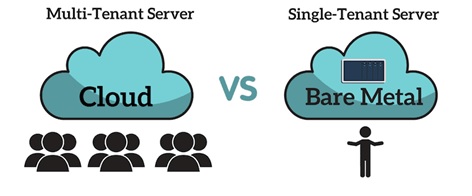Nowadays, when the virtual space is vastly overwhelmed by the amount of data businesses store, companies seek safer and more efficient solutions for digital infrastructure. A Virtual server has remained a go-to solution for many years; however, its reliability and ability to provide stable access to the stored information can often become compromised for various reasons. On the other hand, the Bare Metal server can become a more secure option for companies. Let’s see which solution your business should go for and compare Bare Metal vs Virtual Server.
Let’s define each type of server equipment
At first, it is going to be worthwhile to understand what each type of server providers and how they differ. Let’s begin with a Virtual Server. When we refer to a virtual server, we usually mean a physical server located at an off-site data centre. Therefore, in this case, one physical provider turns into several digital widgets with their own operating systems. Multiple users share their resources whilst remaining in control of each server (like New York dedicated server) and the data stored there. The structure of a shared service is the following:
- Data centre with physical hardware equipment;
- Hypervisor gets installed on the hardware to manage multiple tenants;
- Operational System that enables online services to operate;
- Tenants, which are mobile apps and websites.
In contrast, a Bare Metal Server, which is also known as a single-tenant server, is a piece of physical server equipment that does not allow sharing of resources among other tenants, unlike virtual servers the OS gets installed directly onto the hardware. This kind of provider can be placed at a location of your company’s office, which, combined with digital infrastructural separation, allows achieving greater efficiency in its operation, predictability, and security of information storage. Additionally, a single-tenant provider allows setting operational preferences according to the needs of a tenant.
How does Bare Metal and Virtual Servers differ:
If we compare the reliability and efficiency of the two kinds, the Bare Metal Server can provide greater performance due to the fact that it is physically distant from other servers that could potentially interfere in equipment operation, creating a «noisy neighbour» effect. Therefore, if your company requires to process large volumes of digital data, it is better to choose Bare Metal, as it is going to create a stable and continuously operating environment.
Another beneficial aspect of having a single-tenant server is that it makes all the stored information easily available. With Virtual Servers, retrieving information takes some time due to the high volume of requests from other tenants. Not to mention that if the server’s operating capacity is down, getting access to your resources might become impossible for an unknown period of time. However, when you are the only tenant getting access to resources is a simple and predictable process, which would not be disrupted by third parties. Therefore, your company would be able to operate its services efficiently.
Having a bare metal server is considered to be the most secure way of hosting. It comes as no surprise that Virtual Servers lag behind with their perceived safety. The main reason for this is rather apparent, and it spiralled around the amount of clients a server hosts. Because the virtual servers hold a number of users that access their services, there is a possibility for resources being leaked or compromised. However, one tenant servers quickly solve this security issue and provide a secure and efficient environment for their clients.
A Virtual Server can come in handy for those who are unsure about the required processing powers of their websites or applications. It allows to quickly switch between the volumes at no extra cost and effort for tenants. However, if we assess the overall productivity of the two, there is no doubt that a single-tenant server can guarantee greater and undisrupted performance, again due to the fact that it hosts only one client.
The final significant difference is pricing. When you are utilizing a shared service, the cost is calculated based on the resources which you employ. Therefore, speaking in plain language, you only pay for what you use. In contrast, a Bare Metal Server would bill its customers on a monthly basis. Additionally, a single-tenant hosting service would normally come out pricier than the virtual one because of its exclusivity and processing powers. However, if your service does not require operating with industrial-sized amounts of data, the difference in pricing of Bare Metal vs Virtual Server might not be as significant.
